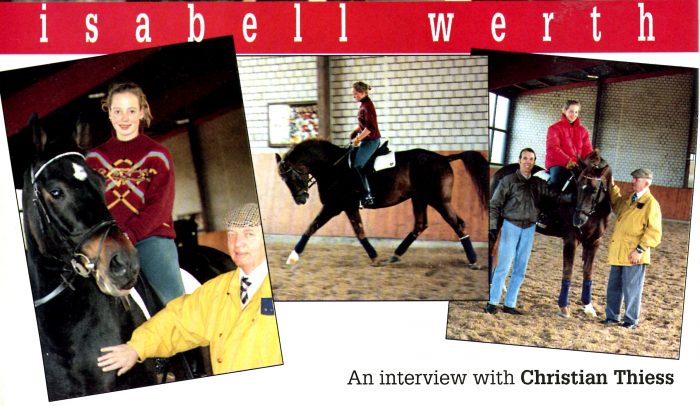
It was back in 1992 when the late Christian Thiess filed this report on the new star of German dressage, 22-year-old law student, Isabell Werth. It was good reading then – and it still is…
When top German trainer, Dr Uwe Schulten-Baumer Snr lost the star of his stable – Nicole Uphoff- after a personality clash, the full time industrialist and part-time dressage trainer shed few tears in public: “I have another pupil,” he assured the press, “she is eighteen years old now and at least as talented as Nicole, soon the world will be hearing from her.” He was right!
The new star is Isabell Werth.
As a youngster, she was an eventing rider, now at twenty two, she is European Dressage Champion. Isabell made the German Team for the European Championships in 1989, with Fabienne, and during 1991, she reached the top of the world on Gigolo with her European Gold Medal.
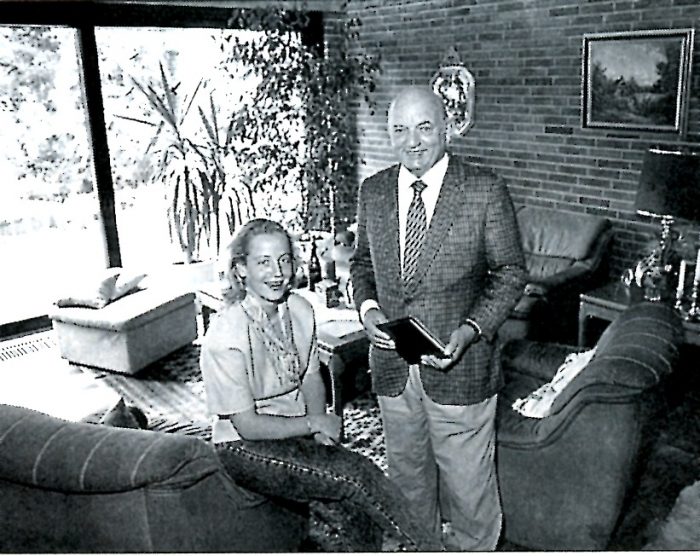
A training day with Isabell Werth and Dr Uwe Schulten Baumer Snr.
The home of Dr Schulten Baumer is in Budberg, a little village in the region of Rheinberg. I was very excited on my way to visit him, because while I got to know the Herr Doctor pretty well from a series of international competitions over the last three years, I have never seen him training his pupils at home.
The setup is very private.
Towards the left, at the entrance is Dr Schulten Baumer’s house where he lives with his family. On the right, opposite the house are the stables, with six spacious boxes and the adjoining facilities. Behind the stables is the indoor arena of 20 m x 40 m, and behind that the outdoor arena of 20 m x 60 m, as well as a lunging arena.
Since it was in the middle of winter, only the indoor arena was being used. The indoor arena is extremely light and airy, with three of the four walls being made up almost entirely of windows. Because they have so much natural light, Herr Doctor said they have no problems with horses bucking or playing up in the transition period from working outdoors.
I was impressed with the beautiful surroundings and setup, as well as the hospitality, the Doctor and Isabell showed towards me. I felt the whole time that I was a welcomed guest.
In total, they have eight horses in work, six on the property, and two on a neighbouring farm, where there are also some other horses belonging to two young riders who the Doctor trains.
The stars of the stables are European champion, Gigolo, then Fabienne, the Westfalien mare who has been a member of the German Dressage team since 1989, and this year won the Volvo World Cup.
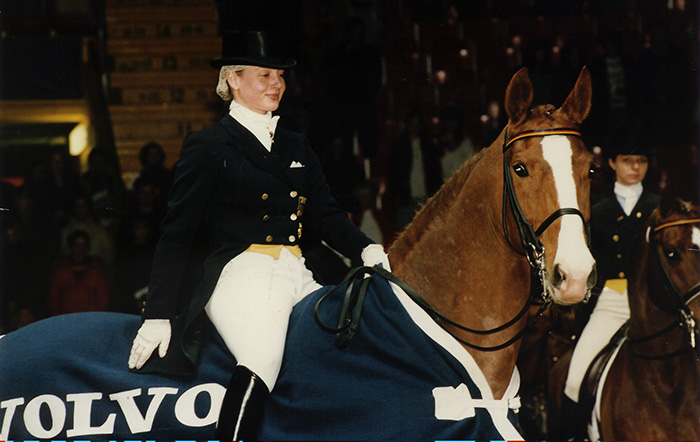
Isabell and Fabienne win the 1992 World Cup Final (note Monica Theodorescu, current German team coach in the background here)
The third star is Antony, a rising six-year-old, dark bay Hanoverian gelding, who has been successful at Medium level. Ridden by Isabell, Antony won the German championships (Bundeschampionate) for five-year-old horses. The other three horses are young ones.
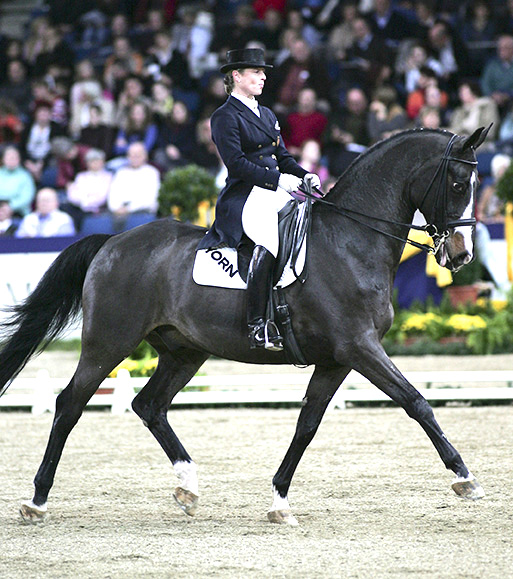
Isabell and Antony competing at Stüttgart at Grand Prix level
The remaining two horses are around six to eight years old, taken over by the Doctor from other riders – horses he likes to experiment with, as was the case with Gigolo.
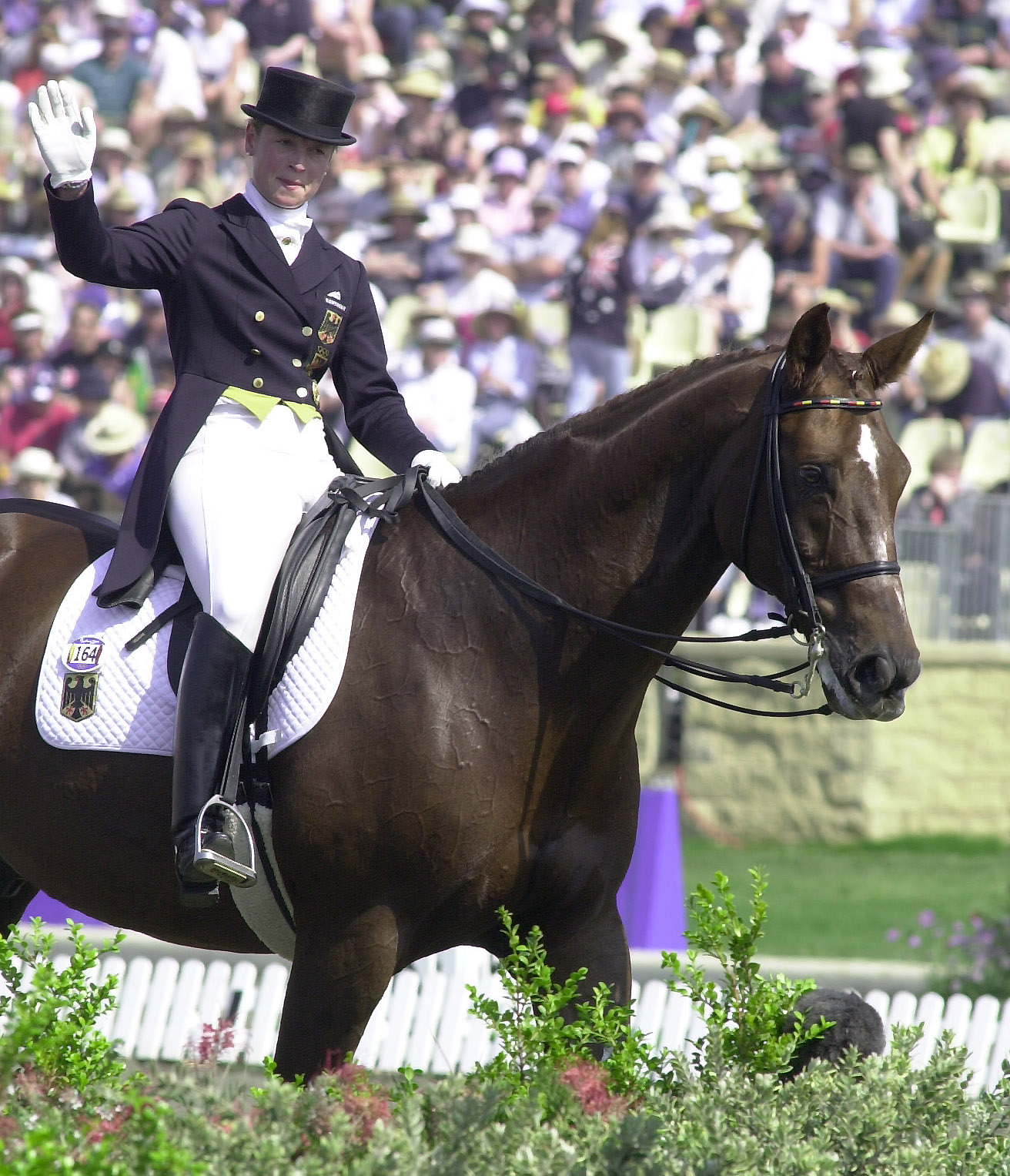
Isabell and Gigolo at the Sydney Games in 2000
Isabell begins riding at about 8.00 in the morning. Because it is not the competition season, all the horses, regardless of their age or level of education, are ridden in relaxation – long, low and round, with the majority working at rising trot and canter, with very little sitting trot or walk, apart from short breaks during the training, with longer periods at the beginning and the end on loose reins. The activity is helped by a Bereiter, employed especially for the pupils of the Doctor.
For the stable work, there are two working pupils, whose duties include making the horses ready to be ridden, leading them to the arena and putting them away when the training session is finished.
At the end of the training, about two in the afternoon, I had time to ask the Doctor a few questions, before he had to leave, when I continued with my interview with Isabell.
CT: Herr Doctor, your horses are now in a period of transition between the competition seasons, and I see that in this period you are working on the basics with a lot of relaxation. Have you turned the horses out at all, and when do you begin with the more demanding work?
Dr S-B: I don’t give the horses any rest periods, only the intensity of the work is reduced. The horses are mainly ridden in relaxation, which means long, and low, and it is in this long and relaxed outline that the young horses are taught new movements. The more advanced horses are exercised in this relaxed manner as well as doing the movements they are already established in.
The closer we are to a competition, the outline begins to change and we will work more towards the necessary elevation and collection that is required. Of course, the intensity of the work is also increasing. The training session from a gymnastic point of view is becoming more demanding.
CT: I see that you use double jointed snaffle bits. Do you prefer them to the single jointed snaffle?
Dr S-B: The double jointed bit seems to work better and I can feel that they are softer. I cannot make the statement that one or the other is better, it is different from horse to horse.
CT: Do you ever use running reins in your training?
Dr S-B: Yes, I use them sometimes. In fact, we have here an older mare, belonging to a pupil of mine, with whom we use running reins a lot.
CT: For lunging do you use side reins or some other form of equipment?
Dr S-B: We use normal side reins.
CT: Do you ever use a Chambon or a Gogue?
Dr S-B: Usually not. I have used them in the past with a horse who used to come above the bit. In fact, we do not lunge much – only the young horses.
CT: How do you go about putting a Kür program together?
Dr S-B: We put together all the artistic programs here. The music is made by a specialist. We explain a little bit how we would like the music to be, and he puts it together. We make a video of the Kür and send it to him with precisely defined times, he then fits the music to this. He is a specialist in both the musical and technical fields.
CT: The freestyle programs have become very professional. What is your feeling about the Kür?
Dr S-B: I think we are moving more and more away from Dressage as a sport through the Kür. We have to deal with too many subjective moments. The other side I don’t like is that everybody tries to introduce new movements with a higher degree of difficulty, which naturally increases the demands on the horse. For example, nowadays, you never see a Kür without at least a double pirouette. That is why I am not a friend of the Kür. I am a friend of the classical riding where you can compare each of the movements with each competitor. I personally do not support the idea that the Kür attracts more spectators. I think that the people who go to the tournaments are watching with equal interest a Grand Prix or a Grand Prix Special as they would watch a Kür.
CT: Do you really think so?
Dr S-B: Yes. I definitely believe it. Take Aachen. In Aachen the stands are full during the Kür, but I think there would be the same number of spectators if a Grand Prix Special was being ridden. Look how many people are watching the Grand Prix Special, for example in Bremen, Dortmund or Stuttgart, the stands are full.
At this stage, Dr Schulten Baumer had to leave, so my next question was directed to Isabell Werth.
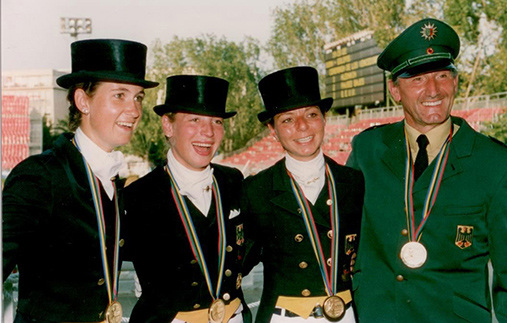
In the Gold Medal team later in the year, in good company, Nicole Uphoff, Isabell, Monica Theordorescu and Klaus Balkenhol
CT: What are your thoughts on the Kür
lW: I agree entirely with Herr Doctor.
CT: Don’t you find it beautiful when the movements of the horse and the music fit together perfectly?
lW: Of course, but the problem is the judging. It is difficult enough to judge the technical execution correctly, because the valuation of the human is subjective. But if you add to that the appreciation of the music and the artistic part which would be valued more than the technical part… The choreography has a co-efficient and in this case, the artistic part is valued better than the technical which causes a problem. I think that the marking system has to be improved.
CT: Could you tell me a little about your life since the European Championships?
lW: After winning the championships, I had a very stressful life – television, radio, gala evenings, everything connected with a lot of travel, now everything has settled and I find more time to study.
CT: How do you find time for your university studies?
IW: I ride horses in the morning. I do not often go to the lectures because the University in Bochum is over an hour and a half travelling time. I do a lot of work at home, where I make notes.
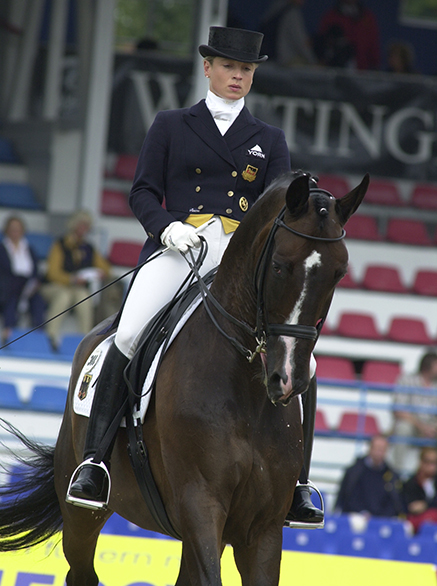
CT: Which of the young horses do you have the highest hopes for?
IW: Tony (Antony) of course. He is very advanced for his age, rising six. He is really a top horse, and I have great hopes for him. The next horse is Aurelus, a four year old, and a three year old which we got a short time ago from the Auction. They are both very talented. They both have the ability to actively use their hind legs. If you put your legs on, you feel in both that they have the ability to collect. They both have natural suspension, which you need for piaffe and passage. They have to have this quality naturally. Of course, you can teach this to a certain degree, but for the top of the top horses, they must have this quality naturally in them. I can train the horse to do a little bit of piaffe, but they would need to have the natural expression.
CT: What are your future plans?
IW: We are trying now to give the older horses a relaxed period and we are concentrating more on the young horses. We will then begin to prepare for the competitions in Dortmund and the trials for the Olympic Games. My aim is to qualify for the Olympic Games.
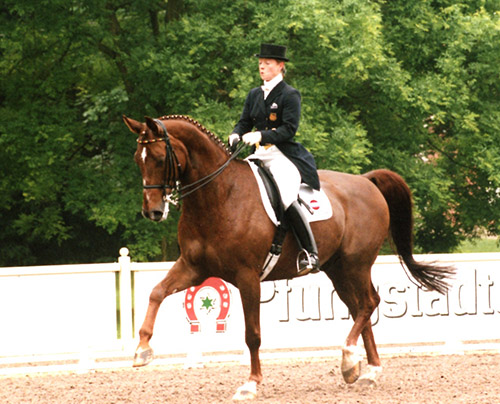
CT: The judges were in the past not so positive towards you and Gigolo?
IW: That is true. But in Aachen my performance wasn’t very glorious. However in Wiesbaden, Gigolo went very well, but one of the judges placed me fifth, and therefore deprived me of a win. I was very disappointed and asked myself, what can I do? I can ride as well as possible but if a judge gives me 20 – 30 marks less than the other judges, I have no chance, and have to accept it. However then things changed for the better. In Rotterdam it was pretty good, then in a competition in Aachen, my performance was border line, and the first day at the European Championships I was pretty happy – because in Donaueschingen, where they held the Championships, there was no time to hold the usual Intermediaire II warmup test, it was straight into the Grand Prix and that is difficult for inexperienced horses like Gigolo.
On that first day we had problems right from the beginning when Gigolo shied at a cameraman who was too close, then everything went pretty well, except for a few little mistakes, like in the one times changes.
CT: What was Harry Boldt’s contribution as National Trainer?
IW: I must say that the help from Harry Boldt as National Trainer is a good thing. We all have our own trainers. Monica has her father, Sven Rothenberger has Herr Schumacher, Nicole Uphoff now has Harry Boldt, and I have the Doctor. It must be a harmonic relationship between trainer and pupil. I always feel this relationship is very harmonic because Harry Boldt brings a lot of calm to the relationship.
On top of this if you train every day with the same person, there are little mistakes which somebody from outside will pick up, not big mistakes but just little things. For example sometimes he would say: “I feel now that your could go a little more collected” or something similar, and he is talking about these things with the Doctor and the Doctor is very happy to have such good co-operation and a working relationship. Like I said before, Harry Boldt brings a lot of calm, especially before a test when you are yourself nervous. Then he is always so calm.
CT: But the Doctor is also a calm person isn’t he?
IW: He is sometimes very nervous before the test, that is for sure. It is clear that the tension is running high before a test like the European Championships, especially when he puts all his heart into it.
CT: What is your daily program?
IW: In the morning we prepare all six horses. The Bereiter usually rides the four year old stallion whom I seldom ride, because he is so strong even if he is uncomplicated. There usually isn’t enough time to ride them all. In the afternoon the horses are allowed to run free in the arena to have a little more exercise. I do not ride in the afternoon because I need the time to study.
CT: I see that the majority of the work here is to ride the horses long and low, getting them relaxed in the back.
IW: Yes, while we do this relaxation we are trying to teach the horses new movements or exercise them in this manner.
CT: I also see that you ride most of the time in rising trot, seldom sitting.
IW: We do a lot of rising, especially with the young horses to relax their backs because as a three or four year olds, their backs are still developing. We cannot afford any tension in the back, because to get rid of it is very difficult.
CT: I see that you were riding Gigolo in the same way as the young horses…
IW: Yes. He is in the relaxation phase and you could see that between this relaxation, we got him to swing into the passage in a loose manner, followed by a relaxed moment again.
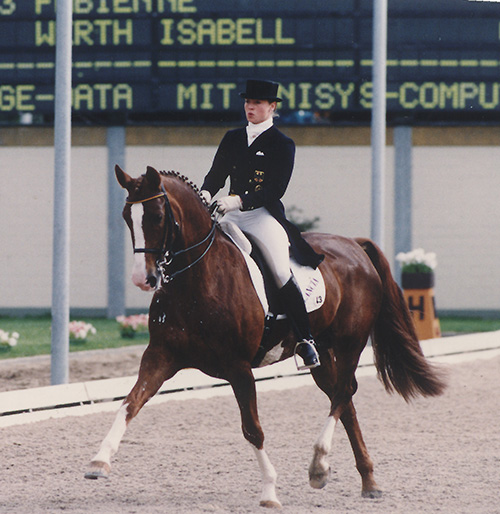
Isabell and Fabienne competing at Aachen in the old arena
CT: Fabienne has a beautifully set on neck, down to a fantastic shoulder. Was her neck like this as a young horse?
IW: She had the wrong muscle development, it is clear that the neck was set on well, but she was as a young horse – in Material classes – always ridden with an erect head and neck carriage so that her muscles developed wrongly and the back was hollowed and the back muscles were not developed.
CT: Do you have any other interests?
IW: No, my riding dictates my whole life. I am not doing any other sports. I just do not have the time. Sometimes I meet friends, I enjoy listening to music, and sometimes I like to read.
CT: What type of horse do you prefer the light-footed horses or the heavier moving horses?
IW: The heavy horses must not move heavily. You cannot say ‘I like this type of horse and not the other’. Each horse is different. Every horse is nice in its own way and impresses through its own personality and that is what we try to encourage in training that the horse maintains its personality.
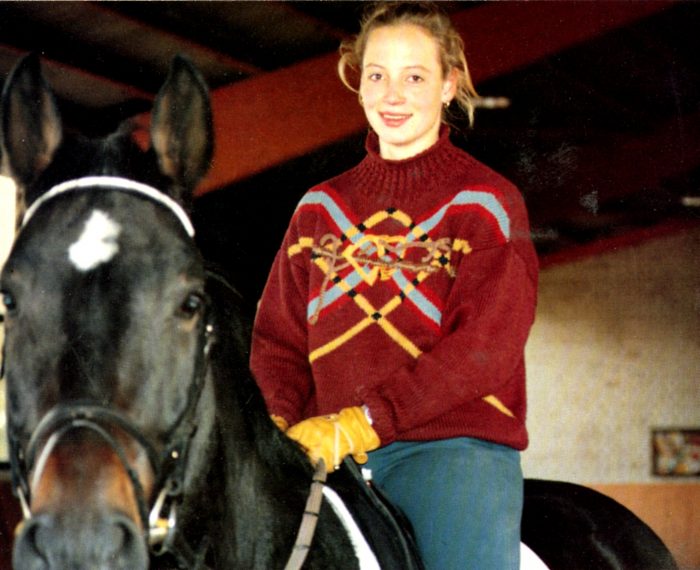
The new star at the time: Gigolo
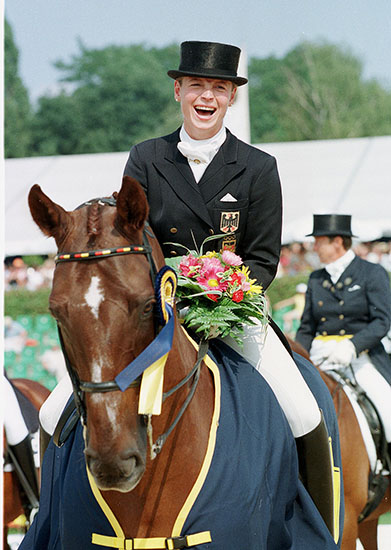
Gigolo is a nine year old, 17.3 hands Hanoverian chestnut gelding by Graditz, out of a Thoroughbred mare by Busoni. Last year, at the age of only eight, Gigolo caused a sensation when he won the European Championships, outclassing the fantastic duo of Nicole Uphoff and Rembrandt by 25 marks! Gigolo’s dam sire, Busoni, won some of Germany’s most prestigious races, including the Oppenhein in Köln.
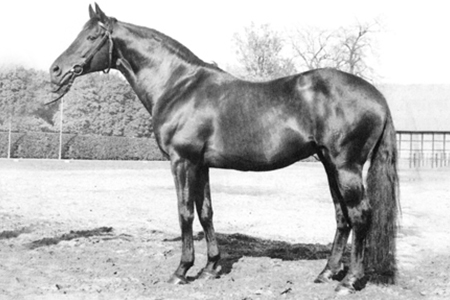
Busoni – the influence of the Thoroughbred
Busoni’s dam was imported as a foal from England. Her grand sire was the legendary Hyperion.
Gigolo’s sire Graditz, is line bred to the Hanoverian stallion, Duellant, who is recognised as a top dressage sire.
Gigolo was successful at Novice and Elementary and reached Medium level at the age of five, when he was bought by Dr Schulten-Baumer Jr. As a six-year-old, Gigolo was taken over by Dr Schulten-Baumer Snr, and since then has been ridden by Isabell Werth.
In 1989, he won four times at Medium level and in 1990 he began to compete successfully at Advanced level.
At the beginning of 1991, Isabell and Gigolo caused an upset when they beat Nicole Uphoff and Rembrandt in the Grand Prix Special for the first time – at Dortmund. As well, they won the German Championships for ladies in Munster (the German championships, somewhat anachronistically, had separate titles for ladies, men and professionals).
Gigolo is described by his owner, Dr Schulten-Baumer Snr, as ‘a horse who has a very good temperament and possessing a high level of intelligence, who has incredibly good paces, especially a very elastic trot.’
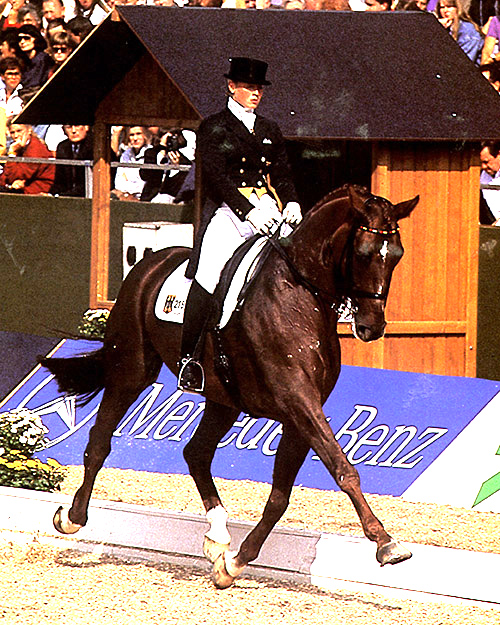
Isabell and Gigolo win the 1991 European Championships
Isabell sees his strong point as being his athletic build: “Rembrandt goes with a lot of charm, Gigolo is more of a sportsman. Rembrandt is always impressive, especially the ease with which he does the piaffe/passage tours and the transitions in and out, I think Gigolo is just as good but more than that, I believe he has more expression than other horses in the piaffe/passage, and in the Grand Prix Special, the piaffe-passage tours are a determining factor.”
Gigolo, the new star has the future in front of him. He is only rising nine …

